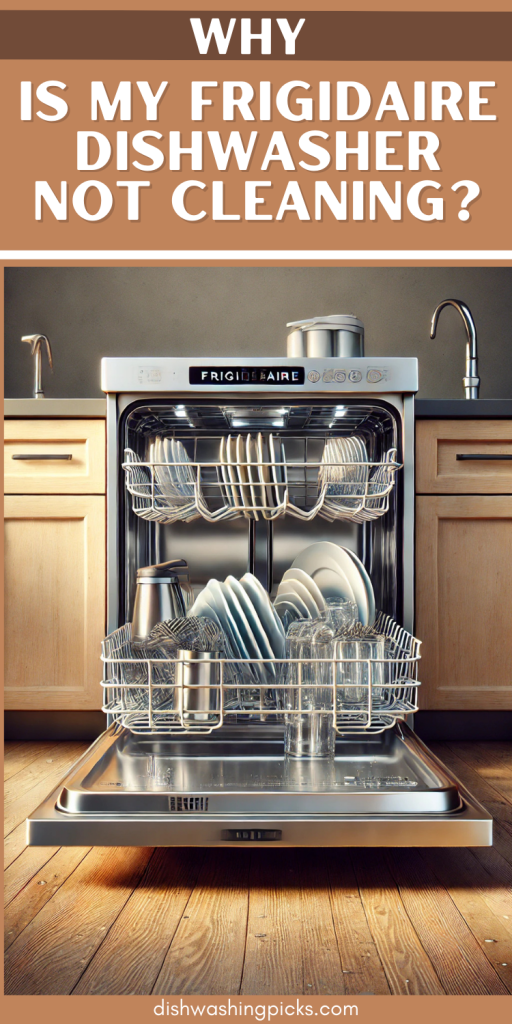
You load up your Frigidaire dishwasher, press start, and walk away feeling like you’ve conquered the world—only to return an hour later and find plates still smeared with last night’s lasagna. What gives? Isn’t a dishwasher supposed to wash the dishes?
Before you start questioning your life choices (or rage-buying a new dishwasher), let’s take a step back. If your Frigidaire dishwasher isn’t cleaning properly, there’s a reason for it. Actually, there are several reasons. The good news? Most of them are easy to fix!
So, let’s break it down. Is your dishwasher leaving food residue? Are glasses coming out cloudy? Maybe the silverware looks like it’s been through a dust storm. Whatever the case, we’re about to troubleshoot it together—step by step.
1. The Spray Arms: Are They Doing Their Job?
Imagine trying to wash your car with a garden hose that only dribbles water. Not gonna cut it, right? That’s exactly what happens when your dishwasher’s spray arms are clogged or stuck. These little guys are responsible for spraying water at high pressure to blast food off your dishes. If they’re not spinning or the nozzles are blocked, your dishes won’t get clean.
Quick Fix:
- Remove the spray arms and check for food debris or hard water buildup.
- Use a toothpick, small brush, or a paperclip to unclog the holes.
- Rinse the arms under warm water and make sure they spin freely before reinstalling.
Pro Tip: If you hear a weird rattling sound during a wash cycle, a spray arm might be hitting an oversized plate or pan. Make sure they have room to move!
2. The Filter: A Hidden Dirt Trap
Did you know your Frigidaire dishwasher has a filter? If not, you’re about to uncover one of the most overlooked reasons for poor cleaning performance. Think of the filter as your dishwasher’s garbage collector—it catches food particles, grease, and all the gunk that shouldn’t be swirling around your dishes. But if it’s clogged, dirty water just keeps recirculating, leaving your plates looking…well, not so fresh.
Quick Fix:
- Locate the filter (usually at the bottom of the dishwasher, under the spray arm).
- Twist it out and rinse it under warm, soapy water.
- Use a soft brush or an old toothbrush to scrub off any stubborn gunk.
- Reinstall it and get ready for cleaner dishes!
Pro Tip: Cleaning your filter once a month keeps your dishwasher running at peak performance. If you’ve never cleaned it before—don’t worry, no judgment. Just go do it now!
3. Detergent Dilemmas: Are You Using the Right Soap?
Let’s talk detergent. Because, believe it or not, the wrong detergent (or even too much of the right one) can leave your dishes looking worse than when they went in. If you’re seeing streaks, residue, or dishes that still feel greasy, your detergent might be the culprit.
Quick Fix:
- Stick to a high-quality dishwasher detergent (pods, powder, or gel).
- If you have hard water, use a detergent with built-in rinse aid to prevent cloudiness.
- Avoid overloading on detergent—too much soap can leave a filmy residue.
Pro Tip: If your dishes come out with white spots, try running a cycle with vinegar in a dishwasher-safe cup to break down buildup. It works like magic!
4. Water Temperature: Is It Hot Enough?
Imagine trying to wash a greasy pan with cold water—it’s a disaster, right? Your Frigidaire dishwasher feels the same way. If the water isn’t hot enough, grease won’t break down, detergent won’t dissolve properly, and your dishes will come out looking like they just survived a food fight.
Quick Fix:
- Before starting your dishwasher, run hot water from your kitchen sink for about a minute to make sure the dishwasher gets hot water immediately.
- Check your water heater settings—Frigidaire dishwashers work best with water at 120–140°F (49–60°C).
- If your dishwasher has a “High-Temp Wash” or “Sanitize” option, use it for extra heat.
Pro Tip: If you’re washing plastic items and they’re still wet at the end, that’s normal—plastic doesn’t retain heat as well as glass or ceramic. A rinse aid can help speed up drying!
5. Are You Loading It Like a Dishwasher Pro?
You might think you’ve mastered the art of dishwasher loading, but even the best of us make mistakes. If dishes are packed too tightly, spray arms can’t reach everything, leaving you with half-clean plates and cups filled with murky water.
Quick Fix:
- Top rack: Cups, glasses, and small bowls—tilt them slightly so water doesn’t pool inside.
- Bottom rack: Plates, pots, and larger items—don’t block the spray arms!
- Silverware basket: Mix forks, spoons, and knives to avoid “nesting” (when utensils stack together and don’t get clean).
Pro Tip: Don’t block the detergent dispenser! If a big pan or plate is in the way, the soap might not even make it into the cycle properly.
6. Time for a Deep Clean?
Yes, your dishwasher cleans dishes, but it also needs a little cleaning itself! Over time, grease, soap scum, and food particles build up inside, reducing efficiency and causing funky smells.
Quick Fix:
- Wipe down the interior with warm, soapy water. Pay special attention to the door gasket and the bottom of the tub.
- Run a vinegar cycle: Place a cup of white vinegar on the top rack and run a hot water cycle (no detergent).
- Use baking soda: Sprinkle baking soda on the bottom of the dishwasher and run a short hot cycle for extra freshness.
Pro Tip: If you live in an area with hard water, mineral buildup can clog spray arms and filters faster. Running a dishwasher cleaner once a month can help prevent that.
7. Reset & Reboot: Sometimes It Just Needs a Fresh Start
If none of the above worked, your dishwasher might be stuck in a weird cycle glitch. A simple reset can sometimes fix unresponsive buttons, incomplete cycles, or random error codes.
Quick Fix:
- Basic reset: Unplug the dishwasher (or flip the circuit breaker) for 5 minutes, then turn it back on.
- Factory reset (for certain models): Hold the Start/Reset button for 3–5 seconds until the dishwasher powers off, then restart it.
- Check for error codes: If an error code pops up, refer to your user manual or Frigidaire’s support website to decode the issue.
Pro Tip: If your dishwasher suddenly stops mid-cycle, a reset is often the quickest way to get it back on track!
Final Thoughts: Should You Call for Backup?
Tried everything and your Frigidaire dishwasher still isn’t cleaning properly? It might be time to bring in the pros. When to call a technician:
- The dishwasher won’t fill with water or won’t drain properly.
- You hear loud, strange noises during a cycle.
- There’s a persistent error code that won’t go away.
A well-maintained dishwasher should leave your dishes sparkling clean, so if it’s giving you trouble, a little troubleshooting goes a long way. Hopefully, these tips help you get back to effortless dishwashing—because, let’s be real, nobody wants to rewash dishes by hand!
Now go give your dishwasher some TLC and enjoy spotless dishes again!
